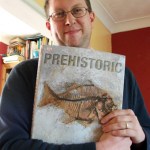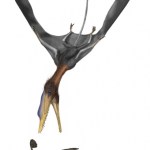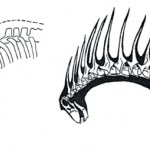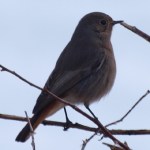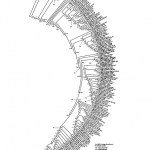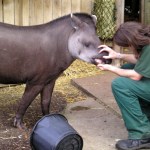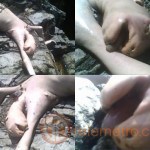On November 7th 2009, the Centre For Inquiry in London is hosting a one-day event titled Monsters From the Deep! It's being held at Conway Hall in Red Lion Square (a venue I know all too well...). I'm giving a talk at the event so wanted to advertise it: for more details please visit the CFI website here. The day kicks off at 11am and will include both talk and workshop sessions. Charles Paxton of the University of St. Andrews, well known for his work on statistical ecology, will be giving a talk titled 'Anecdotes, statistics and sea monsters'. The belief that anecdotal data (in this case,…

The Natterjack Epidalea calamita (introduced in the previous article) is a remarkable animal, well adapted for the dry, relatively saline environments it inhabits (there are places where Natterjacks inhabit saltmarshes, moors, and disused industrial areas). A proficient burrower, it starts digging a burrow with its forelimbs but does most of the work with its hindlimbs (hindlimb burrowing is typical for anurans, whereas forelimb burrowing is highly unusual). The burrows help the toads to gain access to moisture in dry habitats because they typically extend down to damp sediments; a…
If you've been following the toad series, you'll have read articles that introduce toads in general, discuss reproductive biology, and look at cranial anatomy. This can all be regarded as background introductory stuff. From hereon, we're mostly going to look at toad diversity in rough phylogenetic order: that is, starting at the base of the clade and working up to the 'top' of the tree [European common toad Bufo bufo shown here, from wikipedia. This individual has really weird nostrils].
Basal toads are all South American, and include the South American redbelly toads (Melanophryniscus) and…
Yes! MORE TOADS. You surely know what a toad's head looks like. But there's a lot about toad skulls that you almost certainly don't know, and the aim of this article is to review toad skull anatomy. This might seem like an arcane subject, but - as we'll see - the diversity of toad skulls is really quite remarkable and much of toad success can be put down to various of their cranial features (such as their parotoid glands and strong degree of cranial ossification)...
Whereas anurans typically have small teeth lining their upper jaws, toads are entirely toothless. However, tooth-like…
After a brief hiatus we return to the remarkable world of toads, and this time round we look at reproductive biology. As a western European person, the toad species I'm most familiar with (the Common toad Bufo bufo and Natterjack Epidalea calamita [see later articles for details on the name changes]) are seasonal breeders that turn up at ponds early on in the year [Common toad mating ball shown here, photo by Neil Phillips] and produce strings of hundreds or thousands of eggs (between 400 and 7500). There are other toad species that are even more fecund, with individuals of some species (…
Preparing blog posts for Tet Zoo takes hours, sometimes days or even weeks. It's done in "spare time". Putting crap on facebook takes minutes and can be done during the course of a normal work day. Some of the stuff is soooo hilarious it deserves to be shared...
Francisco Gascó (aka Paco) knocked this up, thanks Paco. It was taken in about 1992 1994 (when I was 18 19): note the Battat dinosaurs on the terrarium lid, Greg Paul theropods on the wall, and Luis Rey spiky amargasaur t-shirt. The croc skull is a juvenile C. niloticus.
My one and only photo of a British big cat, taken on Dartmoor…
Regular readers will know that my new book, The Great Dinosaur Discoveries (A & C Black in UK; UCP in US), was released over the last few weeks. By all accounts, it's currently selling well and the reviews that have appeared so far have all been outstandingly positive [example]. Things are looking good. But I work hard, and over the last couple of weeks I've received the news that a second book I completed at about the same time is also now out. Today I received my copy, so can at last talk about it.
Titled Prehistoric here in the UK (and Prehistoric Life in North America), the book is…
Pterosaurs - the charismatic flying archosaurs of the Mesozoic Era - fall fairly nearly into two great assemblages: the primitive, mostly long-tailed basal forms (or 'rhamphorhynchoids') and the more strongly modified, consistently short-tailed pterodactyloids. Pterodactyloids emerged in the Middle Jurassic and persisted to the very end of the Late Cretaceous, and fossils show that they did an awful lot more in their evolution than did non-pterodactyloid pterosaurs. Several lineages evolved giant size, and bizarrely specialised skulls and dentitions show that they took to filter-feeding,…
One of the dirty little secrets of biology is that many groups of organisms have never been 'defined' in the phylogenetic sense: a group grows over time as people add new species to it, but they only do this because it 'feels' about right, not because there's any rigorous way of knowing whether those species really belong there or not. Many tetrapod groups - classic examples include Ranidae, Muscicapidae, Colubridae and Scincidae - lack characters that might allow their monophyly to be demonstrated, and modern studies show that various of their constituent members aren't more closely related…
I forget how it started now, but lately I've been very, very interested in toads (yes, toads), so much so that I've felt compelled to write about them. The problem is that toads - properly called bufonids - are not a small group. On the contrary, this is a huge clade, distributed worldwide and containing about 540 species in about 38 genera (as of October 2009). So, there are a lot of species to write about, and covering all or most of them is quite the challenge. But it's the sort of challenge I like...
As is so often the case with amphibian and reptile groups, accessible literature that…
For the full story on all of this, you'll have to nip over to SV-POW! I guarantee you won't regret it. My favourite 'fact' about potto neck spines: they demonstrate a link with the Chupacabras (no, I don't accept this, but some do take it seriously, apparently).
Observant readers will have noticed problems with Tet Zoo's format over the last few days. This now seems to be sorted, but an unfortunate result is that what's known as my Free Module is now gone. This is the region of the sidebar that had the book adverts and links, web counter, awards, endorsements, paypal icon etc. Bummer. Trying…
One of the most famous of 'missing' birds is the elusive Night parrot, an obscure nocturnal species discovered by John McDouall Stuart in 1845 (though not named until 1861). Small, reluctant to fly, highly nomadic and cryptically coloured, it's never been well known and even now there are only 23 or so specimens in collections. You might know the Night parrot as Geopsittacus occidentalis but many ornithologists now regard it as so close to the Ground parrot Pezoporus wallicus that both are included within the same genus (and Pezoporus Illiger, 1811 is older than Geopsittacus Gould, 1861).
By…
Thanks to everyone who had a go at identifying the Moroccan passerine pictured here yesterday, and shown here again. As virtually everyone said, it's a female or juvenile male redstart (Phoenicurus). The fact that it was seen in Morocco in December makes an identification as Common redstart P. phoenicurus unlikely, as this species winters further south than the Atlas Mountains. At the time I ruled out this species, as the bird shown here has a browny/greyish breast (rather than a buffy/orange one) and a very pale eye ring. Moussier's redstart P. moussieri - which also occurs in the region…
Here's a bird I saw in the snowy Atlas Mountains last year...
Can you tell me what it is, and - better (as I know the answer) - can you tell me something interesting about it? Photo by Bob Loveridge.
As you'll know if you're familiar with the literature on the Loch Ness monster - and as you won't if you're not - Nessie is not only seen in the water; there are, in fact, quite a few claimed sightings that were made on land. The most interesting thing about these accounts is that they're radically divergent, and it would seem that all manner of surreal giant monsters lurk in the bushes and woods around the loch. Here are a few of my favourites.
In 1932 Colonel Fordyce and his wife reported a shaggy-furred, long-legged, long-necked camel-like creature (shown above). It crossed a road to get…
I received some really nice cards for my birthday last week. But this has to be my favourite... (oh, after the one from the kids of course)...
I mean, how often do you see Balaeniceps rex on a birthday card? Not often enough in my view (with a nod to those who have a phobia of this daunting bird). The image is by Elizabeth Diggins. Thank you Tina!
First of all, here are some temnospondyls. This composite image was compiled by repositioning the reconstructions provided by DeFauw (1989): looks neat, doesn't it?
So, I recently returned from the 69th Society of Vertebrate Paleontology meeting, this year held in Bristol, UK: in other words, OUTSIDE OF NORTH AMERICA for the first time ever. It was combined with another meeting I normally attend, SVPCA (Symposium on Vertebrate Palaeontology and Comparative Anatomy), but I think that people sometimes forgot about this. The meeting was enormous and the sheer quantity of talks and posters, and…
After all that talk of tapirs biting people's arms off and killing Brazilian farmers, it only seems appropriate to post these pictures, taken at Bristol Zoo on Sunday (a group of us went there after SVP). The keeper obviously has a great relationship with Denzil, the male Brazilian (or Lowland) tapir Tapirus terrestris on the right (the female, on the left, is called Tamang)...
As for Meller's duck Anas melleri - a species you'll now be very familiar with - I find that they do not hesitate to attack humans, should the opportunity arise...
Still working hard to catch up after SVP, still…
I am reliably informed that a book I wrote during 2008 - The Great Dinosaur Discoveries (A & C Black, 2009) - is now out and available in the shops.
If you like my stuff you will, hopefully, want to own a copy: it's high quality, very nicely illustrated, and not all that expensive. While dinosaur books are typically arranged in either phylogenetic or geological fashion, my aim with The Great Dinosaur Discoveries was to show how our knowledge and understanding of dinosaurs has itself evolved over the decades. This sort of thing has only really been done a few times before. Ned Colbert…
Yet again the world is going nuts over a weird, ugly carcass that is being identified by some as an alien, as a genetic mutation 'of some sort' (duh?), as a deformed dolphin (seriously: what?), or as an unidentified 'monster' that perhaps represents a new species. I've lost track of how many emails I received yesterday about the thing. It's being dubbed the Cerro Azul Monster or Blue Stream Monster or Blue Hill Horror and was discovered at Cerro Azul, Panama. As was the case with the Montauk Monster, the animal's real identity is bloody obvious and this is no mystery.
The (almost definitely…






